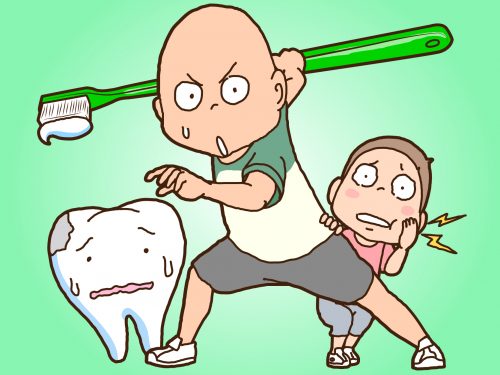Table of Contents
- Parenting Cartoon “Leave the Finish Brushing to Dad”
- Protect your child’s teeth with parents! Cavity prevention is key until the age of 3
Parenting Cartoon “Leave the Finish Brushing to Dad”
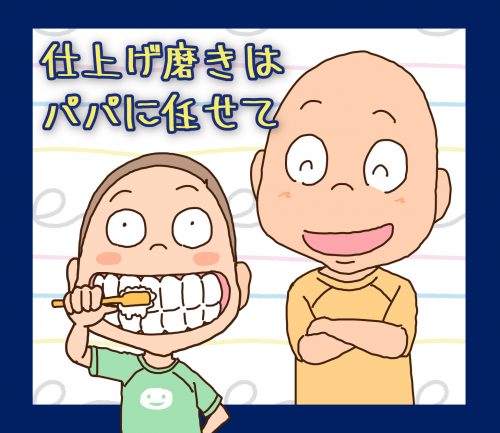
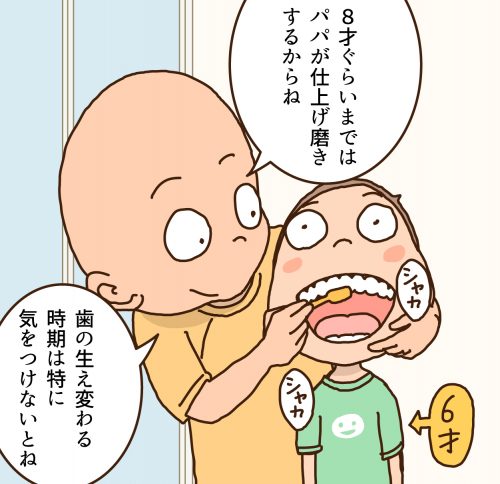
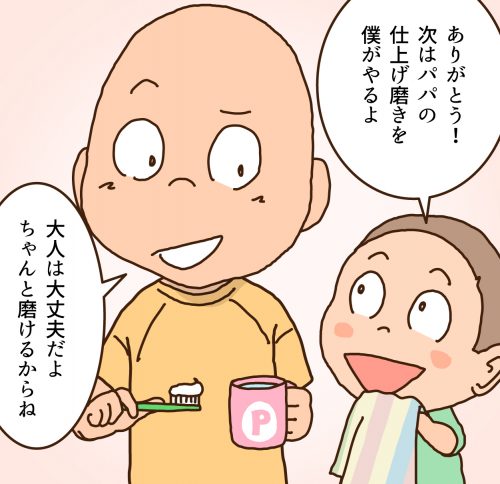
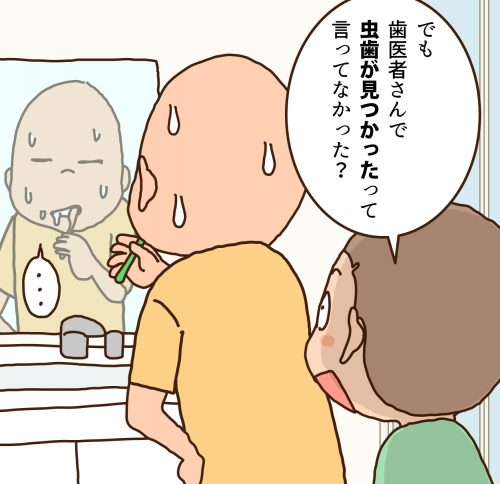
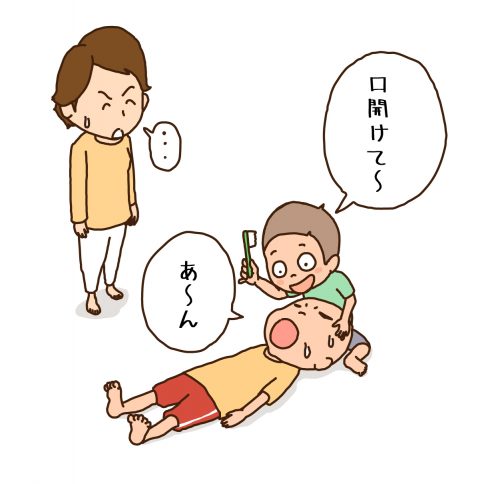

Profile
Eiichi
After working for a design company in Tokyo, he became a freelance illustrator. He is a hard-working father who creates animation, manga, and illustrations, including winning the Yubari International Fantastic Film Festival’s International Short Film Showcase Division Excellence in Animation Award.
Protect your child’s teeth with parents! Cavity prevention is key until the age of 3
Many parents know the importance of taking care of their children’s teeth, but they may not know exactly what to do, or they may struggle with their children’s reluctance to brush their teeth.
This time,
We are pleased to present Dental Care for Children!
We spoke with Dr. Jun Sakabe, a father of four and a pediatric dentist, about routine care and preventive dentistry to protect children’s teeth. He also explains the key points of care for different ages and what to do when children do not want to brush their teeth.

The oral environment that prevents cavities is determined by the age of three!
Tooth decay has two aspects: one is a “lifestyle disease” caused by lifestyle habits from childhood, and the other is an “infection” caused by cavity-causing bacteria. Cavities are passed on from parents when they are babies, but no matter how careful you are, eventually you will get the bacteria somewhere else, so there is no need to worry too much about getting infected. It is more important to take care to prevent the growth of cavity-causing bacteria. It is said that the balance between the number of bad bacteria such as caries and the number of good bacteria that do nothing wrong in the mouth is usually determined by the age of about 3. This will reduce the risk of cavities even after the child grows up.
Protecting Children’s Teeth! Age-specific care tips and precautions
Deciduous and newly erupted permanent teeth are weaker and more prone to decay than adult adult teeth, so routine care is important until the permanent teeth are fully erupted.
Around 6 months old Debut of tooth brushing starts with getting used to the toothbrush.
When the lower front teeth begin to erupt at around 6 months of age, begin brushing the teeth twicea day, morning and night, with a brush-like device. The lower front teeth do not accumulate much dirt because of the high saliva flow, but brushing during this period is a “training aspect” to get your baby used to the sensation of having a foreign object in the mouth. Use a soft, safe silicone toothbrush made for infants to help them get used to the sensation of the toothbrush entering and touching the mouth area.
Around 1 to 2 years old Cooperation between husband and wife is important during the “no-early-brushing” stage.
Many parents struggle to brush their children’s teeth every day during the earliest years of life. After the age of 1.5 years, the back teeth erupt and the “cavity period” begins, so it is very dangerous not to brush the teeth because the child is reluctant to do so. If the child does not want to brush, it is important to cooperate with the couple by having the mother soothe the child or having the father hold the child’s arms and legs lightly. Also, showing the child that mom and dad are enjoying brushing their teeth on a regular basis will help create a positive image in the child’s mind.
[Around 3 to 8 years oldBrushing by the user + finishing brush by the parent
From around the age of 3, when baby teeth are fully erupted, children should brush their own teeth in the morning and afternoon, and parents should always brush their children’s teeth at night. Many families stop brushing their children’s teeth when they reach elementary school age, but the early elementary school age is a “cavity-prone period” when teeth are changing. In addition, since the back teeth, called six-year-old molars, take about six months to erupt, they often decay during the process of eruption. If you stop brushing your child’s teeth during this period, the risk of cavities increases greatly, so parents should brush their children’s teeth until they are around 8 years old. It is ideal to have a dentist check whether the child is brushing his or her teeth properly, and to “graduate” from “finish brushing” after receiving a professional’s approval.
Best timing for breastfeeding and pacifier graduation from a dentist’s point of view
After the age of 1.5 years, back teeth erupt and stains tend to accumulate, and the risk of tooth decay due to breast milk increases dramatically. For this reason, from the standpoint of preventive dentistry, we recommend breastfeeding by the age of 1.5 years. However, if this is difficult, there is no need to stop. If you wish to continue breastfeeding, please take preventive measures such as brushing teeth and controlling sweet foods.
Pacifiers can affect the alignment and fit of teeth if they are kept on for a long time or over a long period of time. Especially after the age of 3, the bones gradually harden, and the bad effects often remain even after the teeth replace, so the goal should be to graduate from pacifiers by the age of 3.
Protect your child’s teeth with “finish brushing! Check out the right way to do it!
Finish brushing” is an important care to prevent tooth decay by checking for any leftover toothpaste from children’s “own brushing” and by thoroughly removing stains. Adults should brush their children’s teeth every day without fail by following these important points.
(1) Lay the child on his/her back on his/her lap.
After putting the child to bed, hold the toothbrush in a “pencil” position and brush the cheeks with the index finger of the opposite hand, keeping a clear view of the inside of the mouth. If the child does not want to brush and flaps his/her arms and legs, hold the child’s arms and legs lightly with an adult foot.
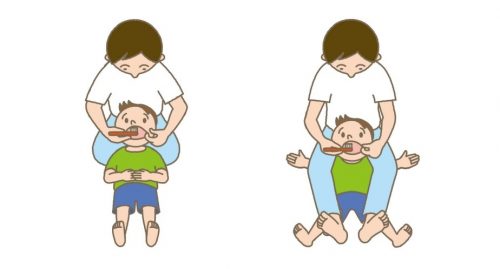
(2) Brush in order to prevent forgetting to brush and to polish evenly.
If you brush from the easiest areas, you will inevitably forget to brush, so brush in “order”. First, brush the outer side of the upper teeth, then the inner side, and then the occlusal surfaces of the back teeth. Then, brush the outside and inside of the lower teeth in the same way, followed by the back teeth.
If you decide on the order in which to brush in this way, you will be more efficient, and even if you brush carefully, it should take less than three minutes.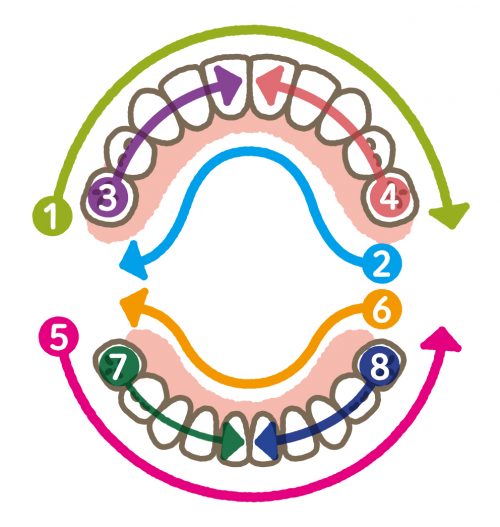
The most reliable way to move the toothbrush is the “scrubbing method.
The “scrubbing method” is to place the tip of the bristles at a right angle to the teeth and move them laterally. This is considered to be the most reliable method, as it causes less irritation to the gums. The key is to brush each tooth or two about 10 times and move the bristles in small increments. The spaces between teeth, which are easily stained, should be brushed thoroughly with a light force, just enough to get the tips of the bristles in.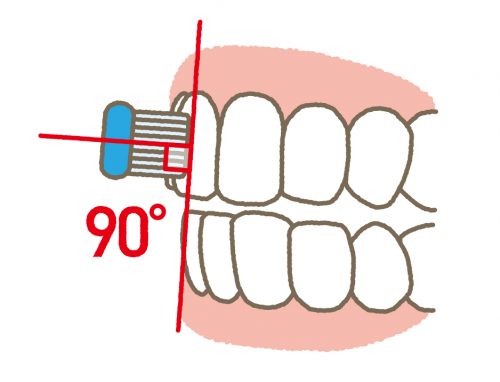
(4) Be especially careful about points that are easy to leave unbrushed.
The inside of the lower back teeth, the outside of the upper back teeth, and the back of the back teeth are the areas that are most likely to be left unbrushed. There is also a muscle called the “upper lip band” between the two front upper teeth. If the toothbrush hits this area, it can be painful and cause the child to avoid brushing his/her teeth. To prevent the toothbrush from hitting the upper lip band, guard it with your finger and brush carefully.
Reduce the frequency of sweet foods! Points to keep in mind when eating
Children get cavities either because they do not brush their teeth enough or because they consume sugary foods too often. It is important for children to develop a regular diet that allows them to control sugary foods. The more often and for as long as there are sweet foods in the mouth, the higher the rate of tooth decay. For example, if 10 grams of sugar is consumed in one sitting versus 1 gram divided into 10 portions, the latter increases the risk of tooth decay. For example, decide on “no more than two sugary foods per day” and do not let them eat them slavishly. If the cravings are unavoidable, it is recommended to control them with sweets containing xylitol, which has the effect of reducing the amount of cavity-causing bacteria.
How to eliminate “Fear of the Dentist!” How to eliminate the fear of the dentist?
If a child sees a dentist for the first time after having a cavity, it is almost impossible to get him or her to think that dentistry is fun. They will have a negative image of dentists as “scary” and “painful,” and they will start to dislike going to the dentist. On the other hand, if the child has a “success experience” of coming to the dentist when there is nothing wrong and getting a reward for their hard work in cleaning their teeth, it is almost impossible for the child to have a negative image of the dentist. Finding a family dentist while the child is young and “going even if there is no problem” is preventive dentistry itself. By having your child’s teeth checked for proper brushing and listening to professional advice, you can improve the quality of care at home. In addition, since the alignment of children’s teeth and their bite are changing day by day, regular checkups once every three months will prevent problems from occurring in the first place and lead to early detection and early treatment in the event of tooth decay.
Dental care that conveys the love of mom and dad
In my dental practice, due to changes in working styles and other factors, I have recently seen more and more fathers not only on weekends but also on weekdays. There are many benefits for dads to actively participate in their children’s dental care, such as fully experiencing their children’s growth and improving communication between the couple. In addition, the love that mom and dad have for taking care of their teeth is sure to be passed on to their children. If you take good care of your children’s teeth on a daily basis and pay special attention to the “cavity-prone period” when their teeth are coming in and changing, there is no need to be too nervous. I myself am a father of four children, and I was conscious not to stress them out by worrying too much about their dental care. Please acquire the correct knowledge and skills, and work together as a couple to protect your precious children’s teeth.




